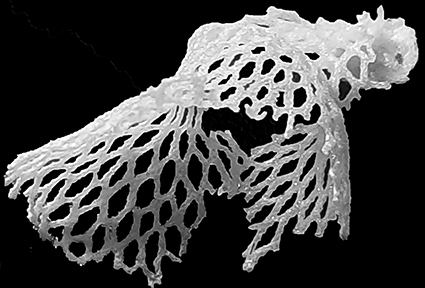Abstract
New species and new records of the cheilostome bryozoan family Phidoloporidae are reported from the poorly studied shelf and continental slope of Greenland. Reteporella vitta n. sp. differs from congeners in the shape and size of fenestrulae, the size of autozooids and their arrangement within the colony, features of the orificial complex, including the indistinctly denticulate distal rim, shape of the condyles and height of the peristome, as well as the shape and location of the suboral avicularium, and the morphology of the ovicell. Reteporella obscura n. sp. differs from other Reteporella species in a unique combination of the following characters: colony surface texture, shape of orifice and condyles, shape of the suboral avicularium, and the morphology of the ovicell. Other specimens of Reteporella from Greenland were identified as R. watersi (Nordgaard, 1907), firstly recorded in southern and western parts of the study area, and as R. grimaldii (Jullien, 1903) and R. beaniana (King, 1846), previously known only from some localities of western and eastern Greenland and recorded abundantly in 2016. Reteporella watersi specimens from Greenland differ from conspecific material from the Faroe Islands in lacking oral spines and in the size of zooidal characters.
References
Bock, P. (2021) Family Reteporellidae Gabb & Horn, 1862. Bryozoa Home Page. Modified on 27 July 2020. Available from: http://bryozoa.net/cheilostomata/phidoloporidae/reteporella.html (accessed 7 November 2021)
Bock, P. & Gordon, D.P. (2021) World List of Bryozoa. World Register of Marine Species. Available from: http://www.marinespecies.org (accessed 10 November 2021)
Busk, G. (1884) Report on the Polyzoa collected by H.M.S. Challenger during the years 1873–1876. Part 1. The Cheilostomata. Report on the Scientific Results of the Voyage of the H.M.S. “Challenger”, Zoology, 10, 1–216.
Denisenko, N.V. (1990) Kola Research Centre of the Academy of Sciences of the USSR Publisher, Apatity, 156 pp. [in Russian]
Denisenko, N.V. (2020) Species richness and the level of knowledge of the bryozoan fauna of the Arctic region. Proceedings of Zoological Institute RAS, 324 (3), 353–363. https://doi.org/10.31610/trudyzin/2020.324.3.353
Denisenko, N.V. & Blicher, M.E. (2021). Bryozoan diversity, biogeographic patterns and distribution in Greenland waters. Marine Biodiversity, 51 (Article No. 73). [published online] https://doi.org/10.1007/s12526-021-01213-9
Denisenko, N.V., Hayward, P.J., Tendal, O.S. & Sørensen, J. (2016) Diversity and biogeographical patterns of the bryozoan fauna of the Faroe Islands. Marine Biology Research, 12 (4), 360–378. https://doi.org/10.1080/17451000.2016.1148817
Hansen, K.B. (1962) Bryozoa. Kom. for videnskab. undersog. i Danmark, C. A. Reitzels forlag, København, 81, 6, 1–74.
Hayward, P.J. (1994) New species and new records of cheilostomatous Bryozoa from the Faroe Islands, collected by BIOFAR. Sarsia, 79, 3, 181–206. https://doi.org/10.1080/00364827.1994.10413558
Hayward, P.J., Kuklinski, P. & Gudmundsson, G. (2020) Bryozoa (mosadýr) in Icelandic waters (BIOICE). Available from: https://www.ni.is/biota/animalia/bryozoa (accessed 1 October 2020)
Hayward, P.J. & Ryland, J.S. (1996) Some British Phidoloporidae (Bryozoa: Cheilostomatida). Zoological Journal of the Linnean Society, 117, 103–112. https://doi.org/10.1111/j.1096-3642.1996.tb02150.x
Hayward, P.J. & Ryland, J.S. (1999) Cheilostomatous Bryozoa. Part 2. Hippothoidea - Celleporoidea. Synopses of the British Fauna, New Series, 14, 1–416.
Jullien, J. & Calvet, L. (1903) Bryozoaires provenant des campagnes de l’Hirondelle (1886-1888). Resultats des campagnes scientifiques accomplies sur son yacht par Albert Ier, prince souverain de Monaco, 23, 1188. https://doi.org/10.5962/bhl.title.2169
Klitgaard, A. (1995) The fauna associated with outer shelf and upper slope sponges (Porifera, Demospongiae) at the Faroe Islands, northeastern Atlantic. Sarsia, 80, 1–22. https://doi.org/10.1080/00364827.1995.10413574
Kluge, G.A. (1962) Mshanki severnykh morey SSSR. Academy of Sciences of the USSR Publisher, Moscow-Leningrad, 574 pp. [in Russian]
Koltun, V.M. (1964) To study of the bottom fauna of the Greenland Sea and the Central Arctic Basin. In: Koltun, V.M. & Balakshina, L.L. (Eds.), Scientific Results of the High Latitudes Oceanographic Expeditions to the Northern Part of the Greenland Sea and Neighboring Areas of the Arctic Basin. Proceedings of the Arctic and Antarctic Institute. Vol. 256. Transport, Leningrad, pp. 13–76. [in Russian]
Kuklinski, P. (2009) Ecology of stone-encrusting organisms in the Greenland Sea—a review. Polar Research, 28 (2), 222–237. https://doi.org/10.1111/j.1751-8369.2009.00105.x
Kuklinski, P., Taylor, P.D., Denisenko N.V. & Berning, B. (2013) Atlantic origin of the Arctic biota? Evidence from phylogenetic and biogeographical analysis of the cheilostome bryozoan genus Pseudoflustra. PLoS ONE, 8 (3), e59152. https://doi.org/10.1371/journal.pone.0059152
Levinsen, G.M.R. (1916) Bryozoa, Danmark-ekspeditionen til Gronlands nordostkyst 1906–1908, Kjobenhavn, 3 (16), 433–472, pls. xix–xxiv.
Maggs, C.A., Castilno, R., Foltz, D., Henzler, C.Y., Jolly, M.T., Kelly, J., Olsen, J., Pezer, K.E., Stam, W., Vainila, R., Viard, F. & Wares, J. (2008) Evaluating sigma signatures of glacial refugia for North Atlantic benthic marine taxa. Ecology, Supplement, 89 (11), 108–122. https://doi.org/10.1890/08-0257.1
Nesis, K.N. (1983) A hypothesis on the origin of western and eastern Arctic distribution of areas of marine bottom animals. Soviet Journal of Marine Biology, 9, 235–243. [in Russian]
Nordgaard, O. (1907) Bryozoen von dem norvegischen Fischereidampfer “Michael Sars” in den Jahren 1900-1904 gesammelt. Bergens Museums Aarborg, 2, 3‒20.
Osburn, R.C. (1919) Bryozoa of the Crocker Land Expedition. Bulletin of the American Museum of Natural History, 41, 603–624.
Pagès-Escolà, M., Bock P.E., Gordon, D.P., Wilson, S., Linares, C., Hereu, B. & Costello, M.J. (2020) Progress in the discovery of extant and fossil bryozoans. Marine Ecology Progress Series, 635, 71–79. https://doi.org/10.3354/meps13201
Puerta, P., Johnson, C., Carreiro-Silva, M., Henry, L.-A., Kenchington, E., Morato, T., Kazanidis, G., Rueda, J.L., Urra, J., Ross, S., Wei, C.-L., González-Irusta, J.M., Arnaud-Haond, S. & Orejas, C. (2020) Influence of water masses on the biodiversity and biogeography of deep-sea benthic ecosystems in the North Atlantic. Frontiers in Marine Sciences, 1, 00239. https://doi.org/10.3389/fmars.2020.00239
Schneider, C.A., Rasband, W.S. & Eliceiri, K.W. (2012) NIH Image to ImageJ: 25 years of image analysis. Nature Methods, 9, 671–675. https://doi.org/10.1038/nmeth.2089
Smitt, F. (1868) Bryozoa marina in regionibus arcticis et borealibus viventia recensuit. Öfversigt af Kongliga Vetenskaps-Akademiens Förhandlingar, 24, 443–487, pls. 16–20.


